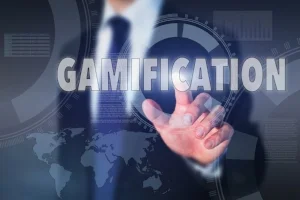Gamification 101
Gamification is a popular buzzword. But what is it really? Is it making your way through a maze of levels on a gaming console? Or maybe it's candy crush on your phone. Perhaps it's collecting points to save up for a cup of coffee at your favorite coffee house. Or it could be a game of Jeopardy to review the content in your your final day of on-boarding.
The truth is gamification encompasses all these aspects and more. It is the use of gaming mechanics, gaming elements, and game theory in a non-gaming scenario. This is a relatively new idea, especially in the education and training space.
As expected, there are different reactions to gamification. Some may love it and rejoice at the new direction of education, some may think it's a gimmick and not to be trusted, and some may even think that gamification is a cure for all for boring training and eLearning out there. Just slap some points, badges, and leader boards on that puppy and BAM! problem of engagement solved.
Wrong.
Gamification is a great tool, but it is just that, a tool within the a larger arsenal of tools to create memorable, motivational and monumental learning experiences. Regardless of whether or not you have an affinity for gamification, it is a trending type of content delivery, and it's important to understand some of the core elements. So let's break gamification down into its basic components.
Motivation
The key to good gamification is knowing your audience. This will help you as a designer know how to motivate your learners. It’s been consistently proven that adult learners need to know why they are engaging in an activity, what is the desired outcome, and how it impacts them. Beyond this, there are many different motivators and definitions of “fun” that drive people to play games. Different gamification elements will appeal to these different motivators, such as risk taking, strategic challenges, social forums, and rewards.
Content & Mechanics
Once you have your audience's buy in it's time to create a good game. What makes a good game? A good game needs to have goals, challenges, risks, and meaningful outcomes. Creating a good challenge requires the designer to create goals defined by specific rules. The experience of the challenge must give feedback that will result in a quantifiable outcome. Hopefully the outcome is positive and will elicit a sense of satisfaction in the leaner.
Before we talk about the creation of the game it's important to know your specific content well and to choose a game mechanic that will complement it. This could include collection, worker placement, luck, deck building, role-playing, resource management just to name a few. Your content and type of delivery should help to inform the game mechanics that will work best for your situation.
Rewards
This brings us to rewards. There are 2 types of rewards to be aware of: intrinsic and extrinsic. Extrinsic is the easier of the two to define. This type of reward is something tangible like a gift voucher, a vacation, or a new phone. Intrinsic rewards are more along the lines of personal satisfaction from a desired outcome; for example - being at the top of the leaderboard. Both types of rewards are useful when designing a gamified experience.
Why Gamification?
Why would you use gamification over other content delivery methods? It comes downs to engagement and motivation. Learners need to understand the content in order to navigate a game successfully. In addition to learners internalizing content, it also taps into their internal motivators through challenges, risk, and reward. These core elements keep learners engaged in the content while fighting off learner fatigue. Using gamification can not only increase initial learning outcomes but also knowledge retention, leading to overall behavior change, which, let's be honest, is the reason we are creating all this fantastic content in the first place.
Wrap Up
So, Gamification in a nutshell:
Know your audience and what will motivate them
Be very familiar with your content and choose a game mechanic to compliment it
Games should consist of challenges, risks, and meaningful outcomes
Learners need feedback through the game
Reward your learners
This is an extremely brief overview of a complex topic. However, just thinking about these key ideas can help spice up any type of training or classroom experience. Gamification is a very fun and powerful tool so remember kids,"With great power comes great responsibility."
